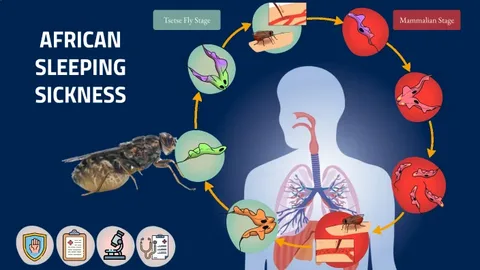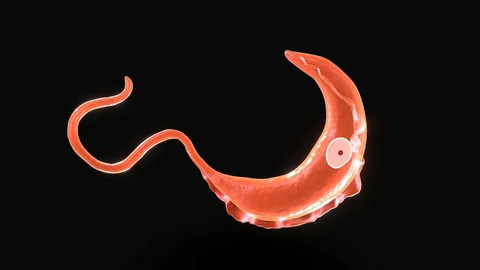Sleeping sickness, also known as Human African Trypanosomiasis, is a serious tropical disease that affects both humans and animals. It is caused by a microscopic parasite and is spread by the bite of the tsetse fly, which lives mostly in parts of sub-Saharan Africa.Even though the name sounds like it just causes sleepiness, sleeping sickness is far more dangerous. If not treated early, it can damage the brain, nervous system, and even lead to death. This disease is called “neglected” because it affects poor and rural communities, and often doesn’t get enough global attention.
Let’s understand everything about sleeping sickness step by step — from how it spreads to how it can be cured and prevented.
What Causes Sleeping Sickness?
Sleeping sickness is caused by a parasite — a tiny organism that lives in the body of another living thing to survive. In this case, the parasite is a protozoan named Trypanosoma brucei.
There are two main types of this parasite:
- Trypanosoma brucei gambiense (T.b. gambiense)
- Found in West and Central Africa
- Causes a chronic form of the disease (can take years to develop)
- Responsible for over 90 percent of all cases
- Trypanosoma brucei rhodesiense (T.b. rhodesiense)
- Found in East and Southern Africa
- Causes an acute form of the disease (progresses quickly in weeks or months)
These parasites are carried and spread by the bite of the tsetse fly, a large biting insect.

How Does the Tsetse Fly Spread the Disease?
The tsetse fly becomes infected when it bites a person or animal already infected with the parasite. After the parasite grows inside the fly, the fly can pass it to the next person it bites.
Transmission Cycle:
- An infected person or animal is bitten by a tsetse fly.
- The fly becomes infected with the parasite.
- The parasite develops inside the fly for about 20 days.
- The fly bites another human or animal, injecting the parasite.
- The parasite enters the blood, then spreads to the lymph system and brain.
This cycle continues unless people are treated and flies are controlled.
Symptoms of Sleeping Sickness
Sleeping sickness occurs in two major stages:
Stage 1 – Early Stage (Hemolymphatic Stage)
This stage affects the blood and lymphatic system. Common symptoms include:
- Fever
- Headache
- Joint and muscle pain
- Fatigue (extreme tiredness)
- Swollen lymph nodes (especially at the neck)
- Itching and skin rashes
- Weight loss
Stage 2 – Late Stage (Neurological Stage)
In this stage, the parasite crosses the blood-brain barrier and affects the central nervous system. This is where the most dangerous symptoms begin:
- Sleep disturbances (daytime sleepiness, night-time insomnia)
- Confusion
- Changes in behavior
- Trouble speaking and walking
- Depression or mood swings
- Seizures (in rare cases)
- Coma and eventually death if not treated
The unusual sleep pattern in stage 2 is why it’s called sleeping sickness.
Diagnosis: How is Sleeping Sickness Detected?
To confirm sleeping sickness, doctors may use:
- Blood test – to detect the parasite in the bloodstream
- Lymph node sample – to check if the parasite is in the glands
- Spinal tap (lumbar puncture) – to find out if the parasite has reached the brain (used for diagnosing the second stage)
Correct and early diagnosis is important because the treatment is different for each stage.
Treatment: How is Sleeping Sickness Cured?
There is no vaccine for sleeping sickness, but it can be treated with medicine, especially if caught early.
Medicines Used:
- Early Stage:
- Pentamidine – for T.b. gambiense
- Suramin – for T.b. rhodesiense
- Late Stage:
- NECT (Nifurtimox-Eflornithine Combination Therapy) – safer and more effective for brain infection
- Melarsoprol – older drug, can have severe side effects but still used in some areas
Important Note:
Treatment must be done in a hospital by trained doctors because late-stage drugs can be toxic if not used properly.
Where is Sleeping Sickness Found?
Sleeping sickness is found in 36 countries in sub-Saharan Africa, mainly in:
- Democratic Republic of Congo (most cases)
- Angola
- South Sudan
- Central African Republic
- Chad
- Uganda
- Tanzania
- Zambia
It often affects remote villages where healthcare is not easily available.
Prevention: How Can We Stop Sleeping Sickness?
Ways to Protect Yourself and Others:
- Avoid tsetse fly areas. These flies are active during the day and live near rivers and forests.
- Wear protective clothing such as long sleeves, long pants, and neutral-colored clothes.
- Use insect repellents (though not always effective against tsetse flies).
- Sleep under insecticide-treated bed nets.
- Install fly traps and use insecticide spraying in villages.
- Conduct regular health screenings in high-risk areas.
- Treat infected people early to prevent the disease from spreading.
Global Efforts to Eliminate Sleeping Sickness
Organizations like the World Health Organization (WHO), Doctors Without Borders, and African governments are working to:
- Improve access to diagnosis and treatment
- Distribute free medicines
- Train healthcare workers
- Monitor and report new cases
- Use mobile clinics to reach remote communities
Goal: Eliminate sleeping sickness as a public health problem by 2030.
So far, great progress has been made. Cases have dropped from over 30,000 per year in the 1990s to fewer than 1,000 cases per year today.
Fun Fact for Students
Did you know? The tsetse fly is one of the few flies that gives birth to live larvae instead of laying eggs. This makes it slower to reproduce, which helps in controlling its population with proper efforts.
Conclusion
Sleeping sickness is not just about being sleepy — it is a serious disease that starts with mild symptoms but can become deadly if left untreated. It mostly affects people in Africa, especially in rural and poor areas.
By learning about how it spreads, what symptoms to look for, and how to prevent it, we can help support global efforts to eliminate this disease and protect lives. Education, awareness, and timely action are key to ending sleeping sickness for good.
Q1: Why is sleeping sickness dangerous?
Because if not treated early, it can damage the brain and lead to death.
Q2: Who spreads sleeping sickness?
It is spread by the tsetse fly, which lives in parts of Africa.
Q3: Can it be cured?
Yes. Sleeping sickness can be cured if diagnosed early and treated with the correct medicine.
Q4: Is there a vaccine for sleeping sickness?
No, there is currently no vaccine, but prevention and early treatment are effective
Q5: Why is it called a “neglected” disease?
Because it mostly affects poor and rural areas and doesn’t get enough attention or funding compared to other diseases.



